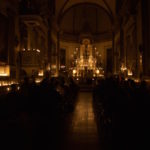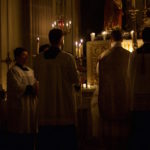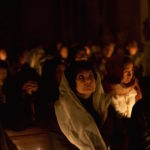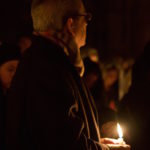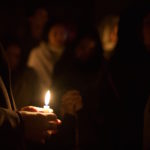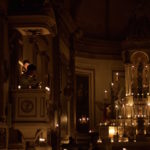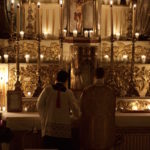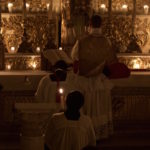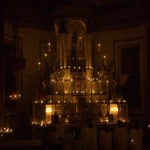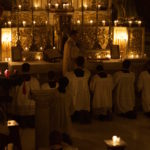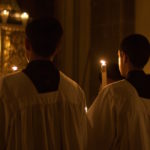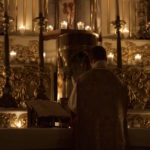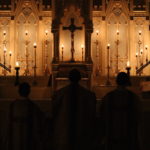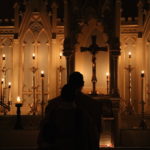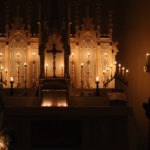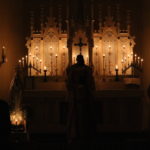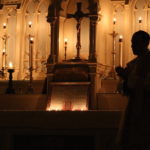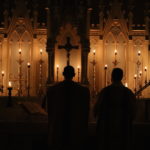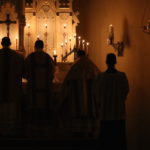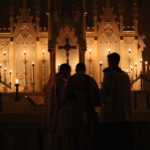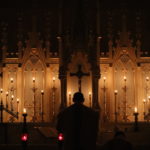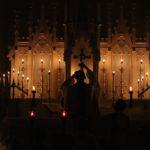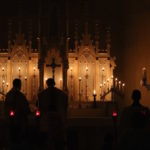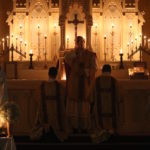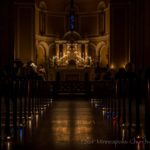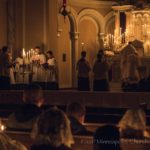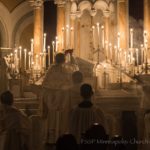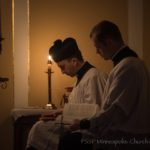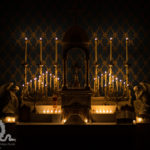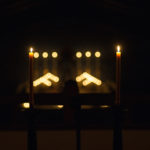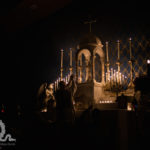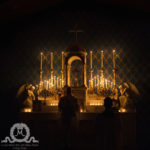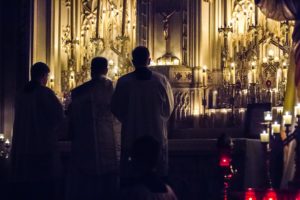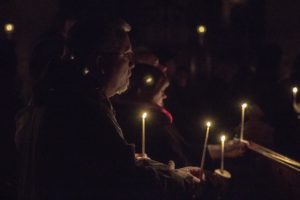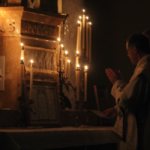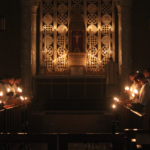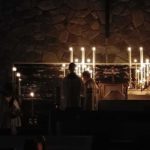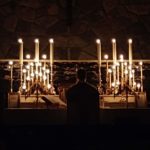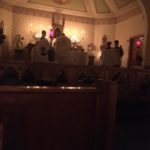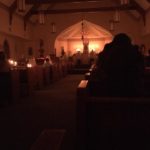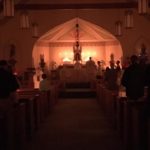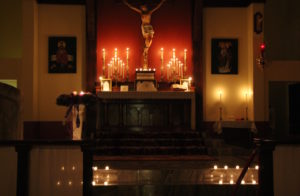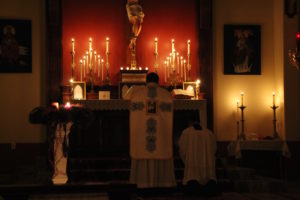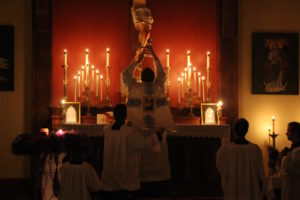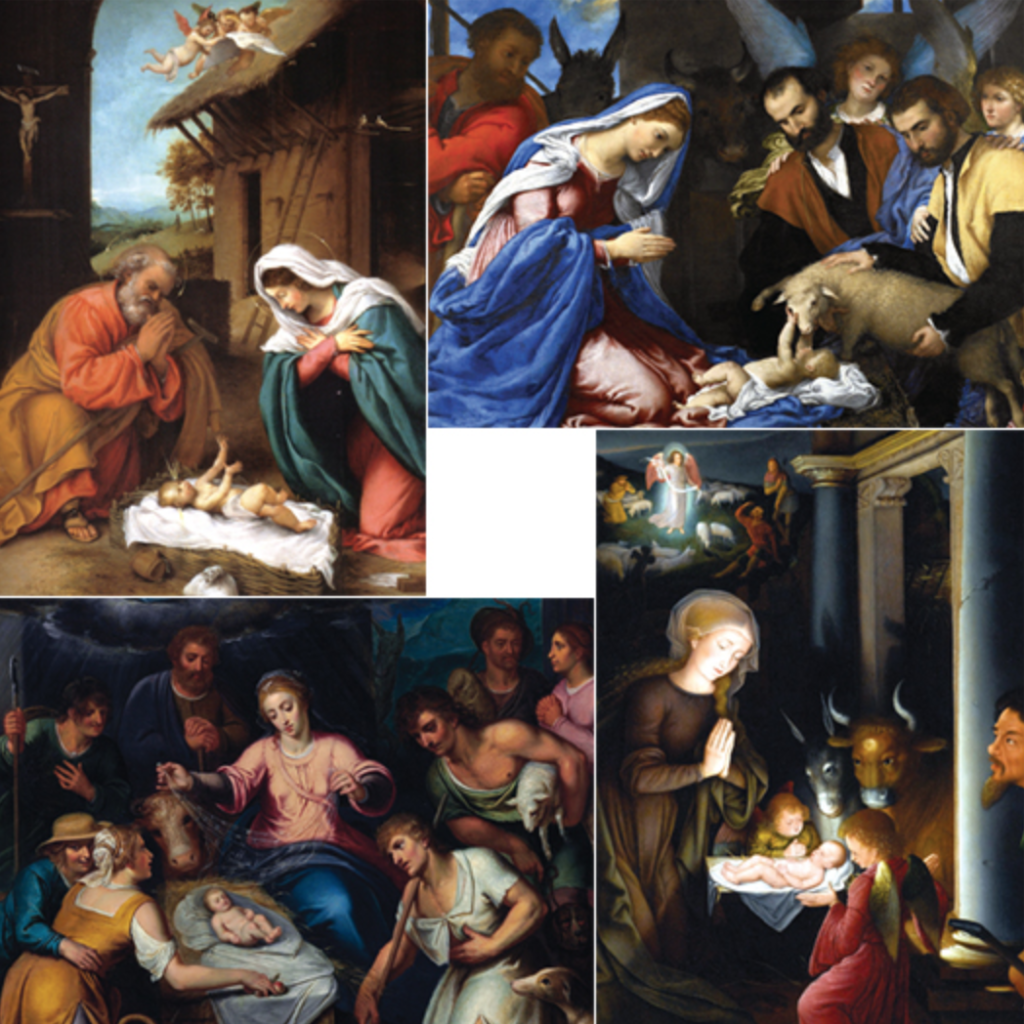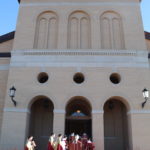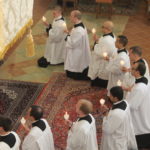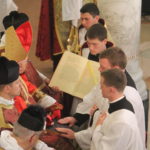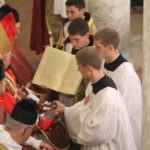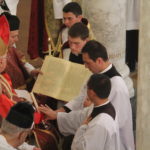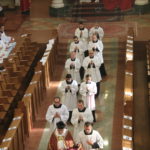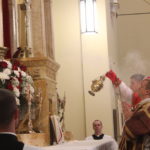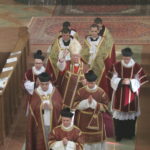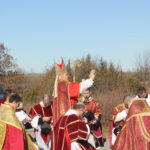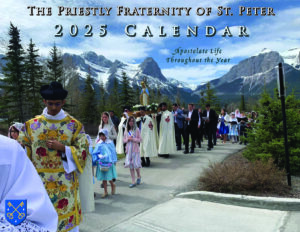Merry Christmas!
We wish you and your families a most blessed and joyful Christmas! May the Christ Child bless you abundantly during this holy season and throughout the New Year!
And in that region there were shepherds out in the field, keeping watch over their flock by night. And an angel of the Lord appeared to them, and the glory of the Lord shone around them, and they were filled with fear. And the angel said to them, “Be not afraid; for behold, I bring you good news of a great joy which will come to all the people; for to you is born this day in the city of David a Savior, Who is Christ the Lord. And this will be a sign for you: you will find a babe wrapped in swaddling cloths and lying in a manger.” And suddenly there was with the angel a multitude of the heavenly host praising God and saying,
“Glory to God in the highest, and on earth peace among men with whom He is pleased!”
Luke 2:8-14
December 25, 2017
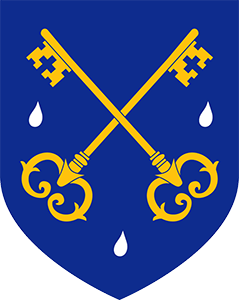
…Y las Nubes LLueven el Justo
…and let the clouds rain the Just.
We received a most beautiful coda to the post we did here on the Rorate Caeli Masses across the District. Photographs from the Rorate Mass celebrated at our mission in Mexico arrived, and they are truly stunning.
To learn more about our work in Mexico and find out how you can help, please visit the mission’s website here.
December 21, 2017

Drop Down Dew, Ye Heavens
On Saturday, December 16th, parishes across the District celebrated the Rorate Caeli Mass, a candlelit, early-morning Mass in honor of Our Lady. The Mass is an Advent tradition of extraordinary beauty in the Church, the candles amid the darkness shining as reminders of the Light Who is soon to come into the world. The sacred grandeur of this Mass is a sight to behold, and we bring you here Rorate Caeli, from Tacoma to Texas, from the west of Canada to the Atlantic shore.
FSSP Tacoma
St. Joseph Parish
FSSP Tacoma welcomed North American District Superior Fr. Gerard Saguto for the Rorate Mass and an Advent recollection. Father was assisted at Mass by St. Joseph pastor Fr. Michael Stinson and parochial vicar Fr. Caleb Insco.
FSSP Minneapolis
Church of All Saints
FSSP Dallas
Mater Dei Parish
FSSP Baltimore
The National Shrine of St. Alphonsus Liguori
Our Lady of Guadalupe Seminary
The seminary celebrated their Rorate Mass on December 9th.
FSSP Calgary
St. Anthony’s Church
FSSP Maple Hill
St. John Vianney Chapel
FSSP Houston
Regina Caeli Parish
This was Regina Caeli’s first Rorate Mass.
December 19, 2017

FSSP Baltimore Featured in Baltimore Sun
Check it out! FSSP Baltimore, stationed at the National Shrine of St. Alphonsus Liguori, was recently featured in the Baltimore Sun! Click here to read the story!
You can light a candle at the Shrine even if you can’t be there in person. Visit St. Alphonsus’ website here and click on the “Candles” tab to make a donation for a candle to be lit for your intentions. All donations go towards the operation of the Shrine. Thank you for your generosity!
December 18, 2017

Apostolate Spotlight: Nashua
When Father John Brancich arrived in Nashua, New Hampshire in the summer of 2016, the Bishop himself was there to greet him.
His Excellency Bishop Peter Anthony Libasci and the parish of St. Stanislaus share an extraordinary bond. Bishop Libasci himself is responsible for bringing the Latin Mass to the Diocese of Manchester, to which he was named in 2011 by Pope Benedict XVI. There was a clear desire, illustrated by the myriad letters that would arrive at his office, among the members of his flock for a Latin Mass in the area. To learn more about the founding days of the parish, we talked to Fr. James Smith, who joined the parish as assistant pastor this past summer after his ordination in May.
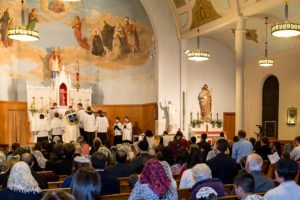
The bishop’s office researched suitable communities that could provide the Traditional Latin Mass and the bishop reached out to the Fraternity, inviting our North American District Superior, Fr. Saguto, to meet with him in New Hampshire. The meeting was a fruitful one, the two superiors sharing common ground in their New York Italian heritage, but, more importantly, in their mutual goal of saving souls and caring for their flocks.

The Bishop gave the Fraternity the 100-year-old Polish church of St. Stanislaus, which was merged with St. Aloysius Gonzaga parish in 2002 and had been closed as a Mass location since that time, but had remained in use as a place of Eucharistic adoration. The Bishop reopened it as a parish in 2016, Father Brancich celebrating the first Sunday Mass on August 7 of that year. The size of the extant Latin Mass community was made apparent on that Sunday, when 40 young men turned up to offer their services at the altar, and 450 attendees came to the Mass. Since the parish began counting the number of attendees in March of 2017, attendance has increased almost 50%, from 240 to 380 on one Sunday in November.
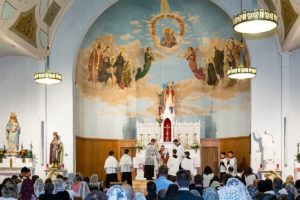
Fr. Smith told us more about the strong friendship the parish has with Bishop Libasci. The Bishop sat in choir during Holy Week at St. Stanislaus and had lunch with the parish on Palm Sunday. He comes to Mass unannounced, says Fr. Smith, and will drop by the rectory at times just to say hello. “He is very good to us,” he says.
Parishioners come from various regions in New Hampshire and from as far away as the dioceses of Worcester, Massachusetts and Portland, Maine, one family even coming from the Diocese of Springfield, MA, on occasion.
The urban parish is situated in downtown Nashua, a city of 90,000 people that is the two-time winner of the Money magazine’s annual “Best Place to Live in America” survey (1987 and 1997). As far as New England goes, New Hampshire is one of the more conservative corners, and its lack of income tax and sales tax make it an attractive prospect for many. It also partakes of the cultural benefits of being near Boston, such as access to theaters, museums and other activities. The Massachusetts capital is a little over an hour’s drive from Nashua.
And those are not the only benefits of its geography. The parish is perfectly positioned to become an integral part of the growing traditional Catholic hub in the Northeast. The traditional community that met the Fraternity on its arrival is complemented by that found at the nearby Northeast Catholic College, which has the Traditional Latin Mass weekly and whose talented choir lends its voices to almost every Sunday High Mass at St. Stanislaus. Also close by is the Thomas More College of Liberal Arts, which celebrates the Traditional Latin Mass on Fridays and runs a van to the Latin Mass on Sundays. As well as the choir from Northeast Catholic, the parish is also blessed to welcome the choir from Thomas More on occasion. The video below is from Sunday, May 7, 2017, the 3rd Sunday after Easter.
The Thomas More choir also sang a High Requiem Mass on November 4, just after All Souls Day. Thomas Aquinas College, which celebrates the Latin Mass daily, is looking to open an east coast campus next year, at a location in Massachusetts about an hour and a half away from Nashua.
The growing parish of St. Stanislaus is the first apostolate for the Fraternity in the New England area, and its presence is therefore a source of great excitement and joy in the FSSP community. A U.S. region that has historically been and continues to be such a population center, a gateway of international travel and immigration and a hub of cultural activity is a vineyard of immense potential, and the FSSP goes into the fields rejoicing.
Our thanks to Mr. David Laskey for the photographs used in the text of this article.
December 14, 2017

It’s Not Too Late to Participate in Our Christmas Card Novena!
Happy feast of Our Lady of Guadalupe! Today is the patronal feast of Our Lady of Guadalupe Seminary, and hence today is a particularly joyful day for our seminarians.
You can still enroll your loved ones in our Christmas Card Novena, a novena of Masses celebrated at the seminary from December 17-25. You will receive a set of beautiful Christmas cards to send to those you enroll. Since there is not time now for you to receive your cards and then send back the paper enrollee form, you can instead just include the names of the enrollees in the online enrollment form here.
You can also read more about the novena and Fr. Saguto’s letter for the 2017 novena here. You can see the beautiful designs for the 2017 cards below!
December 12, 2017

Fun Fact: No 4th Sunday of Advent This Year
That’s right. Because Christmas is on a Monday, the Vigil of the Nativity of Our Lord, a Vigil of the 1st Class, takes precedence over the 4th Sunday of Advent on the 24th. So instead of opening your missals to the 4th Sunday of Advent on Christmas Eve, turn over a page or two to the Mass of the Vigil. The last time it happened was 2006, and while it ought to happen every six years, the leap year in 2012 caused an 11 year gap in this cycle. It will next occur in 2023, so enjoy this rare occurrence!
Editor’s Note: The next time after that will be 2028 … the leap year is causing a 5 year gap.
December 9, 2017

Happy Feast of the Immaculate Conception!
A most happy feast day of the Immaculate Conception of Our Lady! Today is a Holy Day of Obligation, so be sure to attend Mass. On this day we recall the singular privilege granted to Our Lady of being preserved from sin from the first moment of her conception. Ever sinless and immaculate, Our Lady’s soul overflowed with all the graces of God and was always in complete union with His Will at every moment, as exemplified by her glorious fiat at the Annunciation. It was through His Most Holy and Immaculate Mother that Christ chose to come into the world to save us, and so let us rejoice and celebrate this feast day in honor of this most excellent Mother!
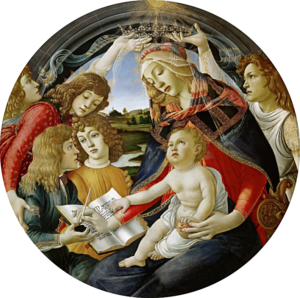 Gaudens gaudébo in Dómino, et exsultábit ánima mea in Deo meo: quia índuit me vestiméntis salútis: et induménto justítiae circúmdedit me, quasi sponsam ornátam monílibus suis.
Gaudens gaudébo in Dómino, et exsultábit ánima mea in Deo meo: quia índuit me vestiméntis salútis: et induménto justítiae circúmdedit me, quasi sponsam ornátam monílibus suis.
I will greatly rejoice in the Lord, and my soul shall be joyful in my God: for He hath clothed me with the garments of salvation, and with the robe of justice He hath covered me, as a bride adorned with her jewels.
Isaiah 61:10, from the Introit for today
December 8, 2017

Minor Orders Conferred in Denton
Twenty-one men of Our Lady of Guadalupe Seminary in Denton, Nebraska, received minor orders on November 25, 2017. Eleven were ordained Exorcist and Acolyte, and ten Porter and Lector. The ordinandi come from many different parts of the world, including various U.S. states, Mexico, England, Scotland and even India!
The orders were conferred by His Excellency the Most Reverend Fabian Bruskewitz, Bishop Emeritus of the Diocese of Lincoln, who celebrated a Solemn Pontifical Mass. Please pray for our seminarians as they take this important step towards the priesthood.
December 5, 2017

Our Lady of Guadalupe Seminary Featured on PBS Newshour
NET, Nebraska’s home for PBS and NPR, recently produced a segment about Our Lady of Guadalupe Seminary! The segment was shown nationally recently on PBS Newshour, and you can watch it here! It will also be shown on the upcoming season of “Nebraska Stories” on NET.
The beautiful 360° video below of the seminarians singing the Divine Office in the Chapel of Sts. Peter and Paul was shot by NET during their filming of the segment.
Please consider donating here to support our seminarians as they study for the priesthood.
November 29, 2017


